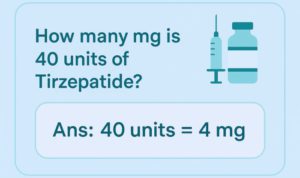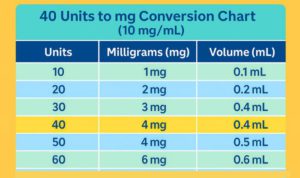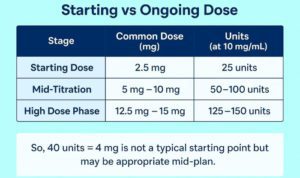
Are you confused about how many mg is 40 units of tirzepatide? You’re not alone. Many people using this medication for diabetes or weight loss struggle to understand the right dose. Is 40 units a lot? How much medicine is that in milligrams?
Before we discuss the specifics, you may want to check out our complete “Tirzepatide Dosage and Unit Conversion Guide,” which breaks down all common unit-to-mg conversions, such as 2.5 mg, 7.5 mg, 12.5 mg, and more, in one place.
In this simple guide, we’ll explain everything in easy terms—no medical jargon, just clear answers. You’ll learn exactly how to convert 40 units into mg, how to measure it safely, and what it means for your treatment. Let’s get started.
Why the 40-unit dose matters
A 40-unit dose means you’re not at the beginning anymore. You’ve likely already started tirzepatide, and your dose has increased slowly. This amount shows your body is adjusting. At 40 units, the medicine starts working stronger. It can help lower blood sugar or support weight loss. But it also means you need to be careful. The dose must be accurate. Too much can cause side effects. Too little might not help. That’s why knowing the exact mg is so important.
How to Convert 40 Units to mg
Measuring tirzepatide in units can be confusing. Especially when your prescription says “40 units,” but your syringe doesn’t show mg. So, how many mg is 40 units of tirzepatide?
The good news is that it’s easy to calculate once you know the concentration. Most tirzepatide comes in a 10 mg/mL strength. That means 1 mL equals 100 units, and every 10 units equals 1 mg. So, 40 units = 4 mg.
We’ll walk you through the full breakdown below so you can measure your dose correctly every time.
10 mg/mL Standard Conversion
The standard concentration of tirzepatide is 10 mg per milliliter (mL). If you’re using this, then 100 units equal 1 mL. That means every 10 units equals 1 mg. So, how many mg is 40 units of tirzepatide? Easy. Just divide 40 by 10. You’ll get 4 mg. That’s your answer.
This method works only if your vial or pen says “10 mg/mL.” Always check the label before drawing your dose. If your concentration is different, the conversion will also be different. However, for most patients, 10 mg/mL is the standard. That’s why this formula helps so many people measure correctly and stay on track.
Best Syringes for measuring 40 Units
Choosing the right syringe is very important for getting your tirzepatide dose right. If you’re taking 40 units, you need a syringe that’s accurate, easy to read, and safe to use. The wrong syringe can lead to the wrong dosing. So, what’s the best syringe for measuring 40 units of tirzepatide? In most cases, a U-100 insulin syringe is the best choice. Let’s explore why.
U-100 Insulin Syringe Overview
U-100 insulin syringes are commonly used for measuring medications like tirzepatide. They’re designed to measure in units, not milliliters, which makes dosing much easier. Since 100 units equal 1 mL in a 10 mg/mL solution, the U-100 syringe gives you exact control over small doses like 40 units.
For example, a U-100 syringe contains 40 units, which equals 0.4 mL. That’s exactly 4 mg if you’re using standard 10 mg/mL tirzepatide. These syringes are widely available, affordable, and easy to use. For safety, make sure to read the numbers clearly and use a new syringe each time.
40 Units to mg conversion chart
If you’re using tirzepatide and need to convert 40 units to milligrams, the chart below makes it easy. Just match the units with mg and mL accurately.

Always double-check your dosage with a healthcare provider to stay safe while using tirzepatide at any unit level.
How often is 40 units used in treatment?
Most people don’t start their tirzepatide journey with 40 units. Treatment usually begins at a smaller dose and then slowly increases over weeks. The 40-unit level often comes later, depending on progress and how the body reacts.
For some, 40 units become a steady, weekly maintenance dose—especially if it controls blood sugar well or supports weight goals. But it’s not a one-size-fits-all dose. Your doctor will decide if this amount is right for you based on your condition, lab results, and overall health.
Can you begin with 40 units?
Starting tirzepatide at 40 units is not recommended. Most people begin with a low dose, like 2.5 mg (25 units), to let the body adjust. Jumping to 40 units too soon may cause nausea, vomiting, or other strong side effects.
Doctors usually increase the dose slowly over several weeks. This step-by-step approach helps reduce risks and gives your body time to adapt. So, no—you shouldn’t begin at 40 units unless your doctor specifically tells you to. Always follow a guided titration plan for best results and safety.
Starting vs Ongoing dose
Understanding the difference between starting and ongoing doses of tirzepatide is key. It helps prevent side effects and ensures you’re taking the right amount as your treatment progresses.

As the chart shows, 40 units isn’t a typical starting dose. It may fit into your mid-treatment plan depending on your doctor’s guidance and your body’s response.
How to Inject 40 units correctly
Taking insulin the right way is very important for your health. If you’re asked to inject 40 units, doing it properly helps control your blood sugar safely. A few careful steps make a big difference in how well it works.
- Use a U-100 insulin syringe
- Wash hands with clean water
- Wipe the vial top with alcohol
- Pull 40 units of air first
- Inject air into the insulin vial
- Draw exactly 40 units of insulin
- Remove bubbles gently and carefully
- Choose and clean the injection site
Be calm and take your time. Injecting slowly and rotating spots can help avoid pain and swelling. Always double-check your dose and follow your doctor’s advice.
How long does 40 units last?
If you’re taking 40 units of tirzepatide weekly, that dose typically lasts for one week. It’s designed to work slowly in your system over seven days. You don’t need to take it daily—just once a week is enough.
However, how long a vial or pen lasts depends on the concentration and how much is inside. For example, a 2 mL vial with 20 mg total could give you five doses of 4 mg (40 units each). Always check your pen’s label and talk to your doctor to be sure how many doses you can safely get from it.
Is 40 units safe for everyone?
When you’ve prescribed 40 units of tirzepatide weekly, that amount typically covers your full week. The medication is long-acting, so you only need one shot every seven days—not daily injections.
Still, the length of your vial or pen depends on its total volume and strength. For instance, if you have a 2 mL vial containing 20 mg, you can get five separate 40-unit (4 mg) doses. It’s always smart to check your device label and confirm the math with your doctor to make sure you’re using it safely and efficiently.
Who should avoid 40 units?
Starting tirzepatide at 40 units isn’t for everyone. This dose is pretty high and can cause strong side effects like nausea or stomach pain, especially if you’re new to the medication. It’s important to be careful and listen to your body.
- New users shouldn’t start at 40 units.
- There is a high risk of nausea and cramps for beginners.
- Avoid if you have kidney problems.
- Be cautious with sensitive digestion issues.
- Skip 40 units if you’re allergic to GLP-1 drugs.
- Don’t increase the dose if lower amounts cause discomfort.
- Always follow your doctor’s gradual dose plan.
Remember, taking tirzepatide safely means starting low and going slow to avoid complications and side effects.
FAQ
What’s the mg equivalent of 40 units of Tirzepatide?
Ans: If your Tirzepatide is 10 mg per mL, then 40 units equal 4 mg. That’s because 40 units is 0.4 mL, and 0.4 multiplied by 10 mg gives you 4 mg.
Is 40 units a usual dose?
Ans: No, 40 units or 4 mg is generally not the starting dose. Doctors typically begin with lower doses, like 2.5 mg, to reduce side effects and increase gradually.
Does 40 units always mean 4 mg?
Ans: Not always. The 40 units equals 4 mg only if your Tirzepatide concentration is 10 mg per mL. Always double-check the medication label before dosing.
Why is it important to know mg for 40 units?
Ans: Knowing how many mg you’re taking helps you avoid overdosing or underdosing. It ensures your treatment is effective and reduces the chance of side effects.
What if I’m unsure about my dose?
Ans: If you’re ever unsure about the mg or units of your Tirzepatide dose, talk to your healthcare provider or pharmacist before making any changes to stay safe.
Conclusion
Knowing the right dose is key to safe and effective treatment. If you’ve ever wondered how many mg is 40 units of Tirzepatide, now you know—it’s usually 4 mg if your vial says 10 mg/mL. Always check your label, use the correct syringe, and talk to your doctor if unsure. The right info helps you avoid mistakes and stay on track with your health journey. Be careful, go slow, and stay safe every step of the way.
Trusted Medical References:
- Drugs.com – Tirzepatide Dosage Information
- Healthline – Tirzepatide Overview & Uses
- RxList – Mounjaro (Tirzepatide) Drug Facts
Medical Notice:
This content is provided for educational purposes only. Do not use it as a replacement for medical advice. Always consult your physician before taking any new medication or altering your dosage.
Reviewed & published by: CMH Health Editorial Team
Hello everyone, I’m Mehedi Hasan — a passionate health content creator and the founder of CMH Healths. Since 2015, I have been researching and writing about health topics with the goal of helping people live healthier and more informed lives. I focus on creating practical, research-based content on health and medicine that empowers readers to make confident, evidence-backed decisions.
